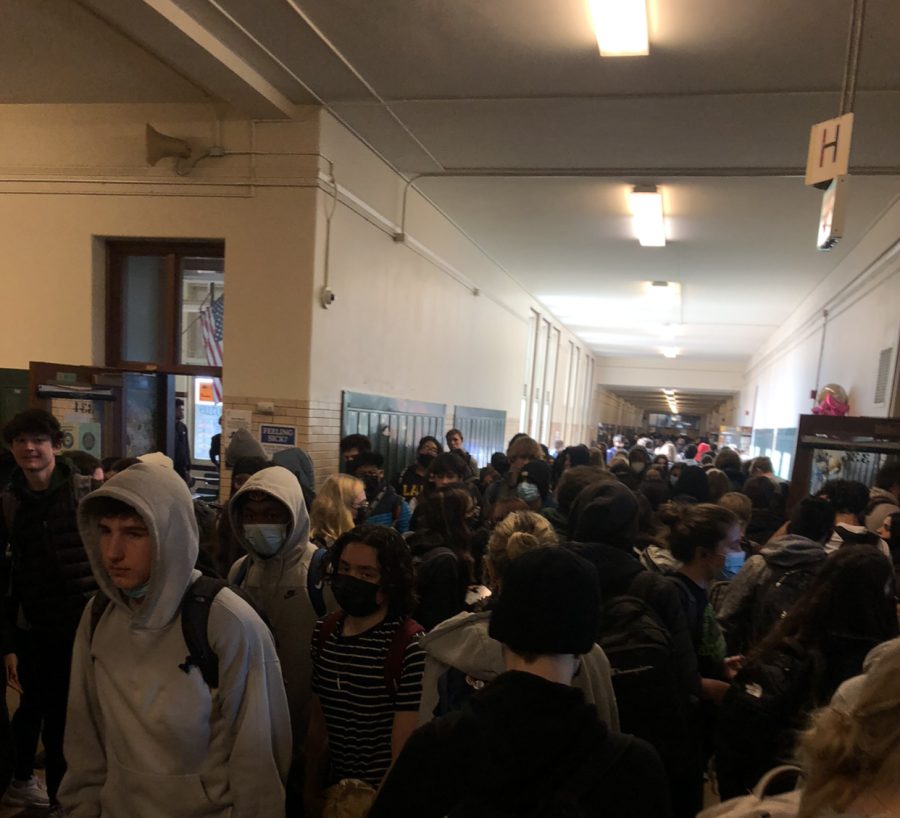Block scheduling: Boo or Booyah?
As soon as the bell rings, the halls become a rush of activity as students go from one class to the next, sometimes having to cross the entire building, and all within five minutes. This is not to mention the human traffic jams where you have to let go of being polite and just shove your way through. Students are constantly in a hurry, barely settling in before having to be on the move again. It is exhausting, and it is draining, and it makes learning, processing and understanding so much more difficult.
Implementing a block schedule, which would mean fewer classes a day for longer periods of time, would solve many of these daily problems.
Walter Payton College Prep is one school where they implement a block schedule, and their model is similar to other schools who also have block schedules such as Northside and Whitney. Essentially at Payton, students have a ten minute advisory every day in the morning, followed by four blocks. The first block is a 90-minute class period and so is the fourth block; however the second and third blocks are a little different. That is because if the second block is a 90-minute class period, then the third block will be a 45-minute lunch period and then a 45-minute class — and vice versa. This shorter class would be gym, gym electives, or a less content heavy class such as English. The next day, for the three blocks with the 90-minute periods, the classes would switch, while the lunch period and 45-minute class would remain the same. It is more complex than the standard eight period day; however people do easily settle in.
There are numerous reasons why a block schedule is beneficial, and while Lane is unique due to its size — which makes it difficult to organize — the benefits of block scheduling still deserve serious consideration.
One benefit is the increased comfort levels within the class that will counteract the previously mentioned stress of navigating the building and traveling to classes. Shala Schmookler, a junior at Payton and former member of LTAC, says that having the longer classes makes the atmosphere more relaxed.
“They give students more time to settle into class, catch up on and recall content and homework, and catch up with the teacher and friends, providing a calmer environment that’s more conducive for learning and for easing stress on students,” Schmookler said.
It is difficult to focus when you are unable to be comfortable, and it is very difficult to be comfortable when you scarcely have time to sit down before teaching begins. A chance to settle into class would help the transition from subject to subject and help students sink into the proper mindset for the class, as teachers do not have the same pressure to rush class and therefore do not put the same pressure upon students.
Another very significant benefit is that block scheduling provides more time for guided application. Under Lane’s current schedule, teachers only have time to introduce and teach concepts in class, with no time to assist students in solving it themselves. When time is given, it’s not enough, and if there is a day for just working on the subject material, it’s fragmented from the original lesson — thus making understanding the work more difficult.
But with longer class periods, teachers can teach the subject matter and then actively help students with their individual work in a more thorough manner.
Brown University’s Education Alliance supports this, as they find that block scheduling allows for more in-depth study, a better ability to incorporate creativity, and more opportunity to address different learning styles. Knowing this will in turn strengthen the interpersonal relationships between students and teachers
With teachers being able to spend a smaller fraction of the class period lecturing or instructing, they can foster relationships with students as they assist them with work in a more in-depth manner than before. Further, Brown University reports that the connection students feel to their teacher is often referred to as one of the most motivating factors for learning.
Yet again, more time in class means a more meaningful learning experience.
The PPLC (Professional Personnel Leadership Committee), a committee which focuses on scheduling changes, desires to capture this experience within Lane.
“We are looking at all different types of creative scheduling where it allows students to have a higher quality, specialized, intimate interaction with the teachers they need to see to get that additional support. That is what we see as a priority for what we are working towards,” said social science teacher Rebecca Daly, who is a member of the PPLC.
Daly said that implementing a block schedule would be difficult due to the size of Lane’s population and number of class options that can be taken. Further, there is the matter of the various stakeholders agreeing to any proposed schedules — the stakeholders being students, teachers, parents and administration.
They are still in the preliminary stages, and creating a better schedule will take time, meaning that unfortunately any improvements will not be put into place soon.
Even if implementing a proper block schedule is not possible, whatever is implemented should attempt to incorporate what makes the block schedule so beneficial.
This means classes with more opportunity for assistance with application to facilitate greater understanding, give students the opportunity to settle into class and increase the positive relationship between teachers and students.
Not only does this improve performance in school as previously mentioned, but more importantly it creates a school which meets the students’ needs to the best of its ability — thus providing a space in which students feel safe and seen.
Your donations directly fund the Lane Tech student journalism program—covering essential costs like website hosting and technology not supported by our school or district. Your generosity empowers our student reporters to investigate, write, and publish impactful stories that matter to our school community.
This website is more than a publishing platform—it's an archive, a research tool, and a source of truth. Every dollar helps us preserve and grow this resource so future students can learn from and build on the work being done today.
Thank you for supporting the next generation of journalists at Lane Tech College Prep!

Saskia is a senior, this is her third year with the Champion. She loves writing and editing, and is planning to pursue a career in English. She spends...





